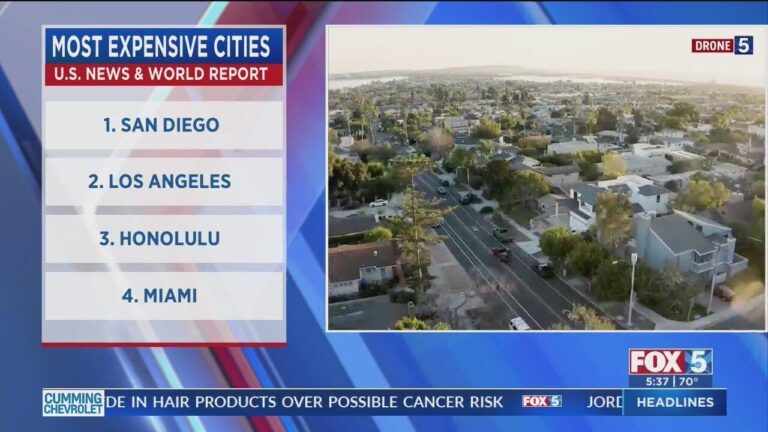San Diego has been officially ranked as the most expensive city to live in the United States, according to a new study highlighted by California Globe. The report, which analyzed various cost-of-living factors including housing, transportation, and daily expenses, underscores the growing financial challenges faced by residents in this Southern California metropolis. As housing prices and general costs continue to soar, the study’s findings raise important questions about affordability and quality of life in one of the nation’s most desirable urban centers.
San Diego’s Skyrocketing Housing Costs Drive Overall Living Expenses
San Diego’s real estate market continues to push residents to their financial limits as median home prices have surged by over 15% year-over-year. This relentless spike has not only priced out many first-time homebuyers but has also escalated rental rates dramatically, compounding the overall cost of living. Local families now find themselves allocating an increasing portion of their monthly income solely to housing, forcing tough decisions on other essential expenses such as healthcare, education, and transportation.
The ripple effect of soaring housing costs is felt across every sector, with many workers facing lengthy commutes from more affordable outskirts, thereby incurring additional costs in fuel and time. Below is a comparative snapshot illustrating the impact of housing expenses on average monthly budgets in San Diego versus the national average:
| Expense Category | San Diego Avg. Cost | National Avg. Cost |
|---|---|---|
| Housing (Mortgage/Rent) | $3,200 | $1,800 |
| Transportation | $650 | $500 |
| Groceries | $450 | $400 |
| Utilities | $200 | $180 |
With these steep costs now the new norm, many San Diegans are exploring alternative living arrangements, including:
- Co-living and shared housing setups
- Relocating to less expensive neighboring counties
- Relying on remote work options to live farther from the city center
Impact of High Living Costs on Local Residents and Businesses
Skyrocketing housing prices and everyday expenses have pushed many San Diego residents into financial distress, forcing a growing number to choose between essential needs. Local families face tough decisions, often prioritizing rent over healthcare or education. Small business owners, in particular, bear the brunt of these pressures, as increasing operational costs-especially rent and utilities-squeeze profit margins and limit their ability to hire or expand.
Key difficulties include:
- Escalating residential and commercial rent leading to displacement and closures
- Dwindling disposable income reducing consumer spending
- Challenges in retaining workforce due to rising living expenses
| Year | Average Rent Increase | Business Closure Rate |
|---|---|---|
| 2021 | 9.5% | 12% |
| 2022 | 11.3% | 18% |
| 2023 | 13.7% | 22% |
Comparison of San Diego’s Expenses with Other Major U.S. Cities
San Diego’s cost of living surpasses many well-known cities across the U.S., solidifying its status as the priciest place to reside. When compared to metropolitan hubs such as New York City, Los Angeles, and Chicago, San Diego consistently reports higher average monthly expenses in key categories like housing, utilities, and transportation. Housing alone accounts for nearly 45% of a typical resident’s monthly budget, outpacing the national average significantly. This steep cost is largely due to limited housing availability coupled with high demand driven by the city’s robust job market and desirable climate.
Other expense categories corroborate the overall elevated spending necessary to maintain a standard lifestyle in San Diego. Below is an overview contrasting average monthly costs (in USD) between San Diego and select major cities:
| Category | San Diego | New York | Los Angeles | Chicago |
|---|---|---|---|---|
| Housing | $2,800 | $2,500 | $2,200 | $1,600 |
| Utilities | $200 | $180 | $160 | $140 |
| Transportation | $150 | $130 | $170 | $120 |
| Groceries | $400 | $350 | $380 | $320 |
Noteworthy drivers behind these expenses include San Diego’s premium real estate market and its coastal location which increases utility costs. Compared to cities like Chicago, where overall costs remain more moderate, San Diego’s climate and lifestyle come with a clear premium that is reflected across daily living expenses. Residents and prospective movers need to navigate these elevated costs carefully when considering relocation or budgeting within the city.
Strategies for Managing the Cost of Living in San Diego
Residents facing San Diego’s high expenses can adopt practical strategies to alleviate financial pressure. Prioritizing budget-friendly housing options such as shared rentals or relocating to less trendy neighborhoods can considerably cut living costs. Additionally, leveraging public transportation or carpooling reduces reliance on costly personal vehicles, directly impacting monthly expenditures. Embracing local markets and discount grocery stores while cutting back on dining out can further stretch household budgets without sacrificing quality of life.
An often overlooked approach involves optimizing utility usage and seeking out available community resources. Turning to energy-efficient appliances, water-saving techniques, and off-peak electricity plans can significantly lower bills over time. Moreover, numerous city-sponsored financial assistance programs and non-profit organizations offer aid for essentials like childcare, healthcare, and food security, providing vital support in a challenging economic landscape. Below is a simple comparison of cost-saving measures to illustrate potential monthly savings:
| Strategy | Estimated Monthly Savings |
|---|---|
| Shared Housing | $800 |
| Public Transit Pass | $150 |
| Energy Efficiency | $60 |
| Local Grocery Shopping | $120 |
Final Thoughts
As San Diego claims the title of the most expensive city to live in across the United States, residents and policymakers alike face mounting challenges related to housing affordability and cost of living. This latest study serves as a critical reminder of the broader economic pressures impacting urban centers nationwide. Moving forward, stakeholders will need to explore innovative solutions to ensure that San Diego remains both a vibrant and accessible community for all.







